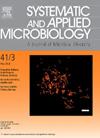Astrobacterium formosum gen. nov., sp. nov., a novel psychrotolerant rosette-forming bacterium from a laboratory psychrophilic EGSB bioreactor
IF 4.2
2区 生物学
Q2 BIOTECHNOLOGY & APPLIED MICROBIOLOGY
引用次数: 0
Abstract
A new psychrotolerant, facultative anaerobic bacterium, strain Astr-EGSBT, was isolated from a syntrophic propionate-oxidizing consortium obtained from a low-temperature expanded granular sludge bed (EGSB) bioreactor fed with a mixture of volatile fatty acids. The cells of this strain were Gram-negative and non-spore-forming rods (0.5·0.8–1.5·9 μm), grew either as individual cells or formed rosettes of various sizes, resembling stars. Bacteria reproduced by budding, and each cell has a sticky, non-reproductive pole that allows them to attach to other cells, forming rosette-like clusters. This strain could grow between 5 and 40 °C, with pH ranging from 4.5 to 7.5 and NaCl concentration of 0 to 2 %. It could degrade a variety of carbon substrates, including sugars, alcohols, casamine acids and several organic acids, but could not grow under photoautotrophic conditions. During glucose fermentation, the products include lactate, acetate, isobutyrate, CO2, and traces of succinate. Major cellular fatty acids were C18:1ω9c and C19:0 cyclo ω9c, menaquinone МХ-10(H10). Main polar lipids were phosphatidylcholine, phosphatidylethanolamine and phosphatidylglycerol. Sequence comparison of the 16S rRNA gene revealed that strain Astr-EGSBT was related to Pseudorhodoplanes sinuspersici RIPI 110T with a similarity of 95.0 %. Based on phylogenomic analysis using 120 marker genes, strain Astr-EGSBT belongs to the distinct genus-level phylogenetic lineage that is most related to the genus Rhodoplanes. The G + C content of genomic DNA was 65.8 mol%. Based on genomic and physiological characteristics of strain Astr-EGSBT, a new genus and a new species, Astrobacterium formosum gen. Nov., sp. nov., is proposed, with Astr-EGSBT as the type strain.
从实验室嗜冷的EGSB生物反应器中获得的一种新型耐冷玫瑰形细菌
从低温膨胀颗粒污泥床(EGSB)生物反应器中获得的合养丙酸氧化联合体中分离出一株新的耐冷兼性厌氧细菌astra - egsbt。该菌株的细胞为革兰氏阴性,不形成孢子的棒状细胞(0.5·0.8 ~ 1.5·9 μm),可作为单个细胞生长,也可形成大小不一的星形莲座。细菌通过出芽繁殖,每个细胞都有一个粘性的非生殖极,使它们能够附着在其他细胞上,形成玫瑰状的簇。该菌株可在5 ~ 40℃、pH为4.5 ~ 7.5、NaCl浓度为0 ~ 2%的条件下生长。它可以降解多种碳底物,包括糖、醇、酪胺酸和几种有机酸,但不能在光自养条件下生长。在葡萄糖发酵过程中,产物包括乳酸盐、醋酸盐、异丁酸盐、二氧化碳和微量琥珀酸盐。主要细胞脂肪酸为C18:1ω9c和C19:0 cyclo ω9c,甲基萘醌МХ-10(H10)。主要极性脂质为磷脂酰胆碱、磷脂酰乙醇胺和磷脂酰甘油。16S rRNA基因序列比较表明,astra - egsbt菌株与sinuspersicpseudorhodoplanes RIPI 110T亲缘关系为95.0%。基于120个标记基因的系统基因组分析,菌株astra - egsbt属于与Rhodoplanes属亲缘关系最密切的独特属级系统发育谱系。基因组DNA G + C含量为65.8 mol%。根据菌株astra - egsbt的基因组学和生理特性,以astra - egsbt为型菌株,提出了新属新种——星状菌formosum gen. Nov., sp. Nov.。
本文章由计算机程序翻译,如有差异,请以英文原文为准。
求助全文
约1分钟内获得全文
求助全文
来源期刊

Systematic and applied microbiology
生物-生物工程与应用微生物
CiteScore
7.50
自引率
5.90%
发文量
57
审稿时长
22 days
期刊介绍:
Systematic and Applied Microbiology deals with various aspects of microbial diversity and systematics of prokaryotes. It focuses on Bacteria and Archaea; eukaryotic microorganisms will only be considered in rare cases. The journal perceives a broad understanding of microbial diversity and encourages the submission of manuscripts from the following branches of microbiology:
 求助内容:
求助内容: 应助结果提醒方式:
应助结果提醒方式:


